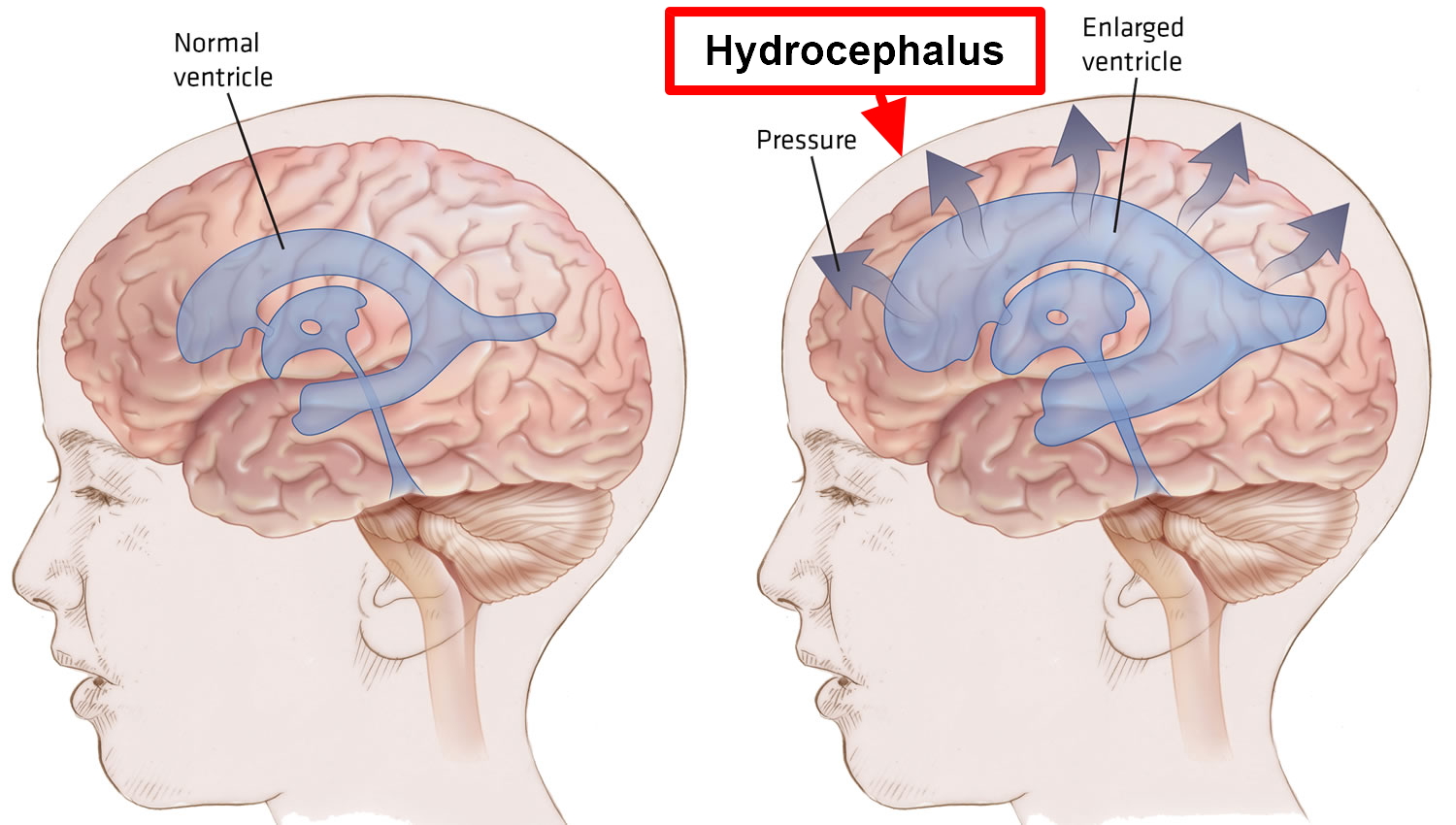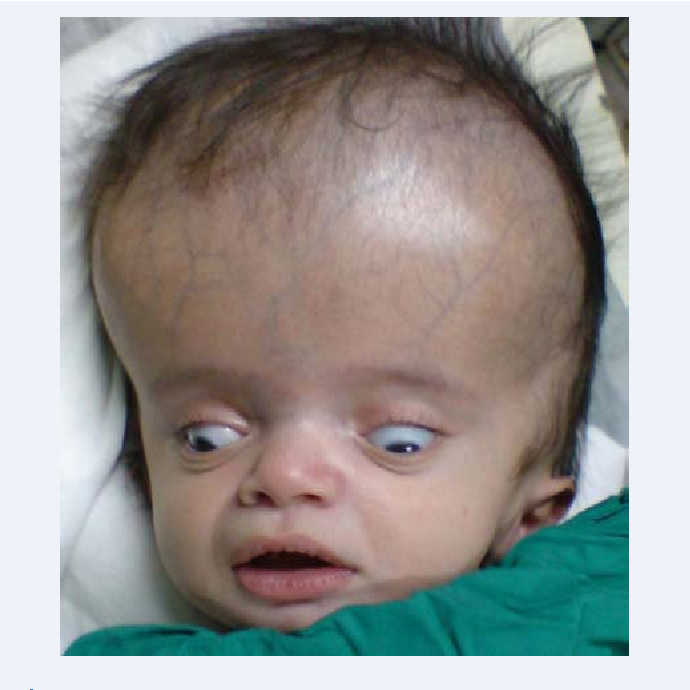

Hydrocephalus is the buildup of fluid in the cavities (ventricles) deep within the brain. The excess fluid increases the size of the ventricles and puts pressure on the brain.
Cerebrospinal fluid normally flows through the ventricles and bathes the brain and spinal column. But the pressure of too much cerebrospinal fluid associated with hydrocephalus can damage brain tissues and cause a range of impairments in brain function.
Hydrocephalus can happen at any age, but it occurs more frequently among infants and adults 60 and over. Surgical treatment for hydrocephalus can restore and maintain normal cerebrospinal fluid levels in the brain. Many different therapies are often required to manage symptoms or functional impairments resulting from hydrocephalus.
Symptoms :
The signs and symptoms of hydrocephalus vary somewhat by age of onset.
1. Infants
Common signs and symptoms of hydrocephalus in infants include:
Changes in the head
• An unusually large head
• A rapid increase in the size of the head
• A bulging or tense soft spot (fontanel) on the top of the head
Physical signs and symptoms
• Vomiting
• Sleepiness
• Irritability
• Poor feeding
• Seizures
• Eyes fixed downward (sunsetting of the eyes)
• Deficits in muscle tone and strength
• Poor responsiveness to touch
• Poor growth
2. Toddlers and older children
Among toddlers and older children, signs and symptoms may include:
Physical signs and symptoms
• Headache
• Blurred or double vision
• Eyes fixed downward (sunsetting of eyes)
• Abnormal enlargement of a toddler’s head
• Sleepiness or lethargy
• Nausea or vomiting
• Unstable balance
• Poor coordination
• Poor appetite
• Seizures
• Urinary incontinence
Behavioral and cognitive changes
• Irritability
• Change in personality
• Decline in school performance
• Delays or problems with previously acquired skills, such as walking or talking
3. Young and middle-aged adults
Common signs and symptoms in this age group include:
• Headache
• Lethargy
• Loss of coordination or balance
• Loss of bladder control or a frequent urge to urinate
• Impaired vision
• Decline in memory, concentration and other thinking skills that may affect job performance
4. Older adults
Among adults 60 years of age and older, the more common signs and symptoms of hydrocephalus are:
• Loss of bladder control or a frequent urge to urinate
• Memory loss
• Progressive loss of other thinking or reasoning skills
• Difficulty walking, often described as a shuffling gait or the feeling of the feet being stuck
• Poor coordination or balance
Causes :
Hydrocephalus is caused by an imbalance between how much cerebrospinal fluid is produced and how much is absorbed into the bloodstream.
Cerebrospinal fluid is produced by tissues lining the ventricles of the brain. It flows through the ventricles by way of interconnecting channels. The fluid eventually flows into spaces around the brain and spinal column. It’s absorbed primarily by blood vessels in tissues near the base of the brain.
Cerebrospinal fluid plays an important role in brain function by:
• Keeping the brain buoyant, allowing the relatively heavy brain to float within the skull
• Cushioning the brain to prevent injury
• Removing waste products of the brain’s metabolism
• Flowing back and forth between the brain cavity and spinal column to maintain a constant pressure within the brain — compensating for changes in blood pressure in the brain
Risk factors
In many cases, the exact event leading to hydrocephalus is unknown. However, a number of developmental or medical problems can contribute to or trigger hydrocephalus.
Newborns
Hydrocephalus present at birth (congenital) or shortly after birth may occur because of any of the following:
• Abnormal development of the central nervous system that can obstruct the flow of cerebrospinal fluid
• Bleeding within the ventricles, a possible complication of premature birth
• Infection in the uterus during a pregnancy, such as rubella or syphilis, that can cause inflammation in fetal brain tissues
Complications :
Long-term complications of hydrocephalus can vary widely and are often difficult to predict.
If hydrocephalus has progressed by the time of birth, it may result in significant intellectual, developmental and physical disabilities. Less severe cases, when treated appropriately, may have few, if any, serious complications.
Adults who have experienced a significant decline in memory or other thinking skills generally have poorer recoveries and persistent symptoms after treatment of hydrocephalus.
Prevention :
Hydrocephalus isn’t a preventable condition. However, there are ways to potentially reduce the risk of hydrocephalus:
• If you’re pregnant, get regular prenatal care. Following your doctor’s recommended schedule for checkups during pregnancy can reduce your risk of premature labor, which places your baby at risk of hydrocephalus and other complications.
• Protect against infectious illness. Follow the recommended vaccination and screening schedules for your age and sex. Preventing and promptly treating the infections and other illnesses associated with hydrocephalus may reduce your risk.
To prevent head injury
• Use appropriate safety equipment. For babies and children, use a properly installed, age- and size-appropriate child safety seat on all car trips. Make sure all your baby equipment — crib, stroller, swing, highchair — meets all safety standards and is properly adjusted for your baby’s size and development. Children and adults should wear helmets while riding bicycles, skateboards, motorcycles, snowmobiles or all-terrain vehicles.
• Always wear a seat belt in a motor vehicle. Small children should be secured in child safety seats or booster seats. Depending on their size, older children may be adequately restrained with seat belts.
